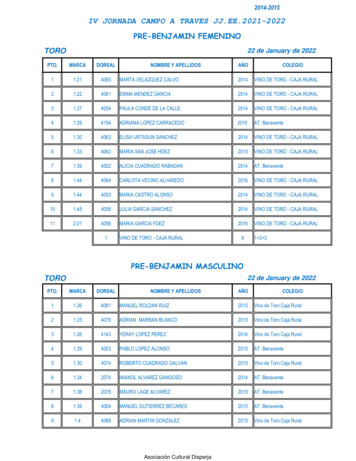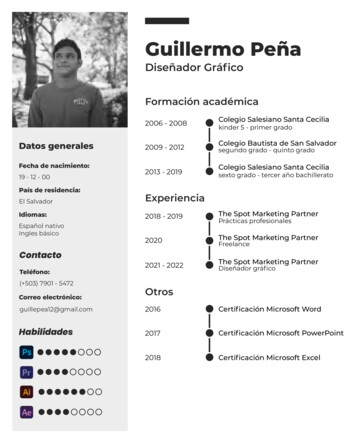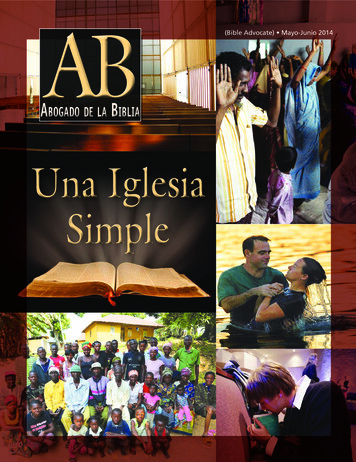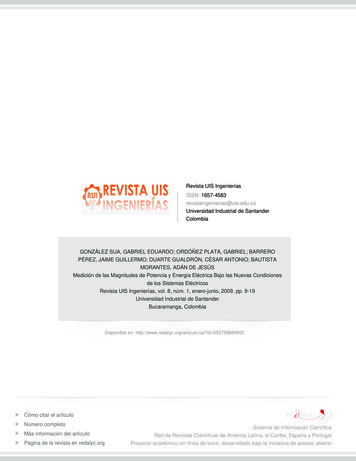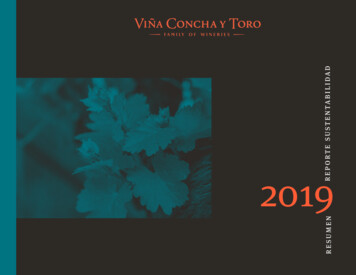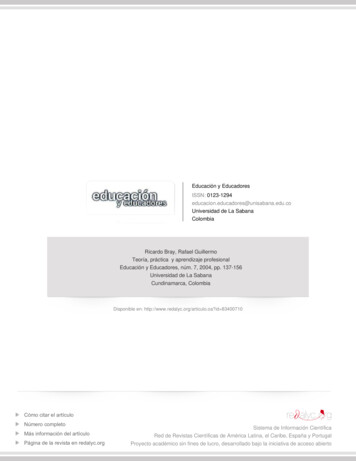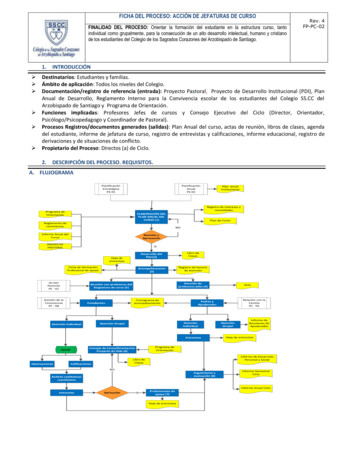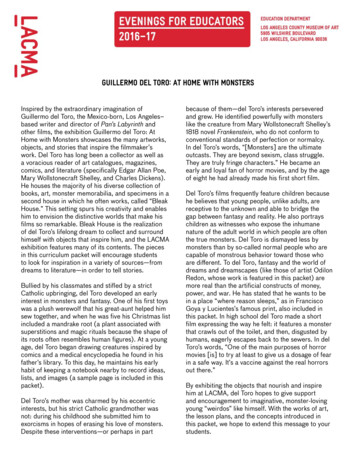
Transcription
Guillermo del Toro: At Home with MonstersInspired by the extraordinary imagination ofGuillermo del Toro, the Mexico-born, Los Angeles–based writer and director of Pan’s Labyrinth andother films, the exhibition Guillermo del Toro: AtHome with Monsters showcases the many artworks,objects, and stories that inspire the filmmaker’swork. Del Toro has long been a collector as well asa voracious reader of art catalogues, magazines,comics, and literature (specifically Edgar Allan Poe,Mary Wollstonecraft Shelley, and Charles Dickens).He houses the majority of his diverse collection ofbooks, art, monster memorabilia, and specimens in asecond house in which he often works, called “BleakHouse.” This setting spurs his creativity and enableshim to envision the distinctive worlds that make hisfilms so remarkable. Bleak House is the realizationof del Toro’s lifelong dream to collect and surroundhimself with objects that inspire him, and the LACMAexhibition features many of its contents. The piecesin this curriculum packet will encourage studentsto look for inspiration in a variety of sources—fromdreams to literature—in order to tell stories.Bullied by his classmates and stifled by a strictCatholic upbringing, del Toro developed an earlyinterest in monsters and fantasy. One of his first toyswas a plush werewolf that his great-aunt helped himsew together, and when he was five his Christmas listincluded a mandrake root (a plant associated withsuperstitions and magic rituals because the shape ofits roots often resembles human figures). At a youngage, del Toro began drawing creatures inspired bycomics and a medical encyclopedia he found in hisfather’s library. To this day, he maintains his earlyhabit of keeping a notebook nearby to record ideas,lists, and images (a sample page is included in thispacket).Del Toro’s mother was charmed by his eccentricinterests, but his strict Catholic grandmother wasnot: during his childhood she submitted him toexorcisms in hopes of erasing his love of monsters.Despite these interventions—or perhaps in partbecause of them—del Toro’s interests perseveredand grew. He identified powerfully with monsterslike the creature from Mary Wollstonecraft Shelley’s1818 novel Frankenstein, who do not conform toconventional standards of perfection or normalcy.In del Toro’s words, “[Monsters] are the ultimateoutcasts. They are beyond sexism, class struggle.They are truly fringe characters.” He became anearly and loyal fan of horror movies, and by the ageof eight he had already made his first short film.Del Toro’s films frequently feature children becausehe believes that young people, unlike adults, arereceptive to the unknown and able to bridge thegap between fantasy and reality. He also portrayschildren as witnesses who expose the inhumanenature of the adult world in which people are oftenthe true monsters. Del Toro is dismayed less bymonsters than by so-called normal people who arecapable of monstrous behavior toward those whoare different. To del Toro, fantasy and the world ofdreams and dreamscapes (like those of artist OdilonRedon, whose work is featured in this packet) aremore real than the artificial constructs of money,power, and war. He has stated that he wants to bein a place “where reason sleeps,” as in FranciscoGoya y Lucientes’s famous print, also included inthis packet. In high school del Toro made a shortfilm expressing the way he felt: it features a monsterthat crawls out of the toilet, and then, disgusted byhumans, eagerly escapes back to the sewers. In delToro’s words, “One of the main purposes of horrormovies [is] to try at least to give us a dosage of fearin a safe way. It’s a vaccine against the real horrorsout there.”By exhibiting the objects that nourish and inspirehim at LACMA, del Toro hopes to give supportand encouragement to imaginative, monster-lovingyoung “weirdos” like himself. With the works of art,the lesson plans, and the concepts introduced inthis packet, we hope to extend this message to yourstudents.
Works CitedDavies, Ann. The Transnational Fantasies of Guillermo del Toro. New York: Palgrave Macmillan US, 2014.Del Toro, Guillermo. Cabinet of Curiosities: My Notebooks, Collections, and Other Obsessions. New York:Harper Design, 2013.Druick, Douglas W. Odilon Redon : Prince of Dreams, 1840-1916. Chicago: Art Institute of Chicago, 1994.Perez Sanchez, Alfonso E. and Eleanor A. Sayre. Goya and the Spirit of Enlightenment. Boston: Museum of FineArts, Boston, 1989.Salvesen, Britt, Jim Shedden and Matthew Welch. Guillermo del Toro: At Home with Monsters: Inside His Films,Notebooks, and Collections. San Rafael: Insight Editions, 2016.Stepanek, Stephanie and Frederick Ilchman. Goya: Order and Disorder. Boston: Museum of Fine Arts, Boston,2014.Zalewski, Daniel. “Show the Monster.” The New Yorker, February 7, 2011, pp. 40–53.These curriculum materials were prepared by Michelle Brenner and designed by David Hernandez. 2016 Museum Associates/LACMA. All rights reserved.Evenings for Educators is made possible by The Rose Hills Foundation, the Thomas and Dorothy Leavey Foundation, The Kenneth T. and Eileen L. Norris Foundation, theJoseph Drown Foundation, and the Mara W. Breech Foundation.Education programs at the Los Angeles County Museum of Art are supported in part by the William Randolph Hearst Endowment Fund for Arts Education and the Margaret A.Cargill Arts Education Endowment.
Bleak HouseAs a child, Guillermo del Toro began collecting booksand objects that intrigued him and assembling theminto meticulous displays in his room, taking refuge inthe intimacy of objects. Today, del Toro houses themajority of his now-expansive collection in a housein Los Angeles near the home in which he lives withhis family. He calls this second house “Bleak House,”after Charles Dickens’s 1853 novel of the samename, in which Dickens describes the dwelling forwhich the book is named as “one of those delightfullyirregular houses where you go up and down stepsout of one room into another, and where you comeupon more rooms when you think you have seen allthere are, and where there is a bountiful provisionof little halls and passages.” The description fits; delToro’s Bleak House is a rambling residence that nowholds more than 550 artworks.The contents of Bleak House have a spiritualhold on del Toro, but they aren’t kept as pristinecollector’s items; instead, he treats the objects inhis collection as items to be explored, interactedwith, and enjoyed. Every aspect of Bleak Houseand its contents is premeditated: del Toro hangseach painting and reviews every detail himself. Inhis words, everything in the house “speaks to me atsome level that is very intimate.” Bleak House “is theworld as I understand it; as it exists in my soul.” Thehouse functions as both his office and his sanctuary.He visits it every day for at least two hours in themorning and one hour in the evening, and when hetravels for work he brings a sample of his collectionwith him to reconstruct this creative environment ona smaller scale; without it, he feels lost.For del Toro, Bleak House is a religious space, andeach object it contains is a talisman or relic. In thiscontext, monsters are his “saints,” and he takes thetask of creating them very seriously. When designinga monster, del Toro begins by thinking of the creatureas a character rather than an assembly of parts.Once he settles on the character, he begins thephysical design. The monster must be convincingfrom all angles, in motion and at rest, and it needs tobe grounded in research; del Toro frequently drawson books of natural history, literature, myth, and art—all of which surround him at Bleak House—as well ashis own dreams, nightmares, and fears. He recordsideas for distinguishing features in his notebooks,often rediscovering them years later. Del Toro alsoreferences objects from his collection: a mountedMalaysian stick bug purchased on a childhood visit toManhattan inspired a sequence in Pan’s Labyrinth inwhich the main character, Ofelia, watches a stick bugon her bed change into a chattering pixie.A former visual effects artist, del Toro is closelyinvolved in the fabrication of his monsters, andhe invites his collaborators to Bleak House forinspiration. After a monster has been designed,del Toro commissions maquettes (preliminarysculptures); even if the creature will be primarilycomputer-generated, he finds that seeing a beast inphysical form helps him to detect its design flaws. Asdel Toro notes, “[My monsters] need to look entirelypossible in their impossibility.” When the monster isfinished, he wants people to say, “What specimenjar did that come from?” Many of the completedmonster maquettes from his movies end up at BleakHouse.Of all the monsters in del Toro’s house,Frankenstein’s creature is the most present andthe most revered. Mary Wollstonecraft Shelley’sFrankenstein is a spiritual touchstone for del Toro,who read the 1818 novel after seeing the classic1931 film version starring Boris Karloff as theconfused and abused monster. A giant sculpture ofthe monster’s head hangs in the Bleak House foyer,directly above one of del Toro’s monsters fromhis 2004 film Hellboy. Full-sized wax sculpturesof Frankenstein’s monster appear elsewhere inthe house, along with numerous paintings andprints, including several from comic artist BernieWrightson’s 1983 illustrated edition of Frankenstein.In Frankenstein’s creature, del Toro sees an innocent
individual abandoned by an uncaring father andforced to suffer for the sins of others. As Wrightsondraws him, the creature has been rudely cobbledtogether from several corpses, but he also possessesa certain grace and emotional power. Similarly, asa filmmaker, del Toro strives to create somethingnoble from a variety of used and discarded sourcematerials.Discussion Prompts1. How do you personalize your own space (i.e., your bedroom, locker, closet, backpack, etc)?2. What is your ideal creative environment or refuge? What places and things inspire you to create?3. What is your most treasured possession? Why do your treasure it? Where do you keep it and why?4. What character from a book or film do you most identify with? What is it about that character that appeals toyou or is familiar to you?
Foyer of Guillermo del Toro’s Bleak House, photograph Josh White/ JWPictures.com
El sueño de la razon produce monstruos (The Sleep of Reason Produces Monsters)1799Francisco Goya y LucientesThe artist with whose work Guillermo del Toroconnects most instinctively is Francisco Goya yLucientes, one of the most important Spanish artistsof the late eighteenth and early nineteenth centuries.Goya was painter to the king of Spain, but he isparticularly known for his dark and disturbing “BlackPaintings” and his paintings and prints depicting thehorrors of the Peninsular War, a conflict betweenNapoleon’s empire and Spain and its allies.The Sleep of Reason Produces Monsters is one ofGoya’s most famous and influential works. It is partof his 1799 portfolio of etchings Los Caprichos,in which the artist set out to ridicule “the vulgarprejudices and lies authorized by custom, ignoranceor interest” and advocate the values associated withthe Enlightenment, whose proponents argued thatwithout reason, evil and corruption would prevail.The portfolio was Goya’s critique of contemporarySpanish society, over which superstition and theCatholic Church loomed large. As a result of itscontroversial contents, Los Caprichos was only onsale for two days before Goya withdrew it from saledue to the threat of the Spanish Inquisition.In this print, a man, most likely Goya himself, sleepsat a desk strewn with drawing materials. He is fullydressed and appears to have fallen into a fitful sleepwhile working. His face is hidden, buried in his arms,and his body slumps over the desk. Behind andabove him, a swarm of bats and owls—creaturesassociated with the night and superstition—descendon him at a swooping diagonal while a calm lynxwatches at his feet. Sinister, glowing eyes stare outat the viewer from the darkness at the man’s back.Goya wrote the following caption for this print:“Imagination abandoned by reason producesimpossible monsters; united with her, she is themother of the arts and source of their wonders.”In other words, unfettered imagination can leadto madness, but when joined with reason, can beharnessed to produce masterpieces. In the contextof the Age of Enlightenment, in which emotion andimagination were seen as in opposition to rationality,Goya asserted that an artist should never becompletely rational or irrational.Here, the creatures in the print emerge from thedarkness of the artist’s mind, as in a dream. An owlto the left of the man takes up a chalk holder (manyof Goya’s preparatory drawings for Los Caprichoswere done in chalk) and points it at the sleepingman, looking at him expectantly. Nearby, the lynxstares out through the darkness (lynxes use nightvision to hunt in the dark), providing a clear-eyed andstable counterbalance to the airborne chaos above.Imagination urges the artist to create, while reasonhelps him make sense of his thoughts and ideas.This vision of artistic creation, in which imagination,joined with reason, unleashes productive creativity, isin keeping with del Toro’s method. Del Toro is ofteninspired by his dreams, and his work certainly evokesnightmares, but he also grounds his artistic practicein the natural world; for example, he insists that hismonsters not only look impressive but also makelogical sense as creatures.
Discussion Prompts1. Goya mocked his society for their superstitions and narrow-mindedness. Can you think of ways in whichpeople today ignore reason and let their imagined fears and prejudices dictate their behavior?2. What are some positive and negative associations with dreams or dreamers, and how are they portrayed inpopular culture (i.e., innovative, not practical, distracting, visionary, etc)? What does the way we see dreamsor visions say about our society?3. Goya felt that imagination should be paired with reason. Do you agree with him? Why or why not? Shouldwe let our imaginations run wild or should imagination always be tempered by reality? What are somepotential consequences of imagination without reason, or reason without imagination?
El sueño de la razon produce monstruos (The Sleep of Reason Produces Monsters)1799Francisco Goya y LucientesEtching and aquatint8 3/8 5 15/16 in. (21.27 15.08 cm)Los Angeles County Museum of Art, Paul Rodman Mabury Trust Fund (63.11.43)
À Edgar Poe (Un masque sonne le glas funèbre) (To Edgar Poe [A Mask Sounds the Death Knell])1882Odilon RedonEdgar Allan Poe has long been one of Guillermo delToro’s favorite writers, and portraits of and books byPoe appear throughout Bleak House. Poe was hugelypopular in late nineteenth-century France and manyartists were inspired by his work, including ÉdouardManet, who in 1875 published a series of printsto accompany a French translation of Poe’s 1845poem “The Raven.” While Manet’s images are literalillustrations of Poe’s text, Odilon Redon’s prints fromthe 1882 series À Edgar Poe (To Edgar Poe) donot depict scenes from the author’s work. Althoughmany nineteenth-century viewers assumed Redon’scaptions were taken from Poe’s writings, they arein fact cryptic titles made up by Redon to evokethe spirit of Poe. In fact, Redon said he only calledthe series À Edgar Poe to generate interest in hiswork by associating it with that of the famous writer.Nevertheless, critics had previously pointed out thesimilarities between Poe’s and Redon’s work, and,regardless of Redon’s conscious intent, the prints area natural fit for Poe’s work.A Mask Sounds the Death Knell evokes Poe’s1849 poem “The Bells,” in which the word “bells”is repeated with darker and darker associationsthroughout the poem, in a progression that has beenassociated with aging and death. In Redon’s print, amasked skeleton exerts a bony grasp on a hangingrope, ringing a bell that signals death (a “deathknell”). The skeleton looks up at the swinging bellwith wide eyes. It is unclear what lies beneath themask: a skull? A head? A pair of eyes? Nothing? Thefigure defies logic; it is a creepy monster announcingdeath in the dark of night.Just as Guillermo del Toro’s movies often makeviewers’ skin crawl, Redon’s macabre and crypticimages made many of his contemporaries uneasy.In an 1882 review of Redon’s lithographs, Parisiancritic Emile Hennequin called the artist a purveyorof “that desolate region which exists on the bordersof the real and the fantastic—a realm populated byformidable phantoms, monsters, monads, and othercreatures born of human perversity.” Another criticdescribed his work as “the nightmare transportedinto art.”Redon was very interested in dreams and theunconscious, then a new psychoanalytic concept.He found the idea of the unconscious mind bothfascinating and terrifying, thinking of it as a primitivesource of inspiration, a dream state free from thestrictures of civilization. Redon associated his workwith dreams, and it was his hope that, without hisbeing aware of it, his unconscious would imbuehis art with additional meaning, allowing viewersto see more in his artwork than he was consciousof depicting. Redon’s artist and writer friendsnicknamed him “the Prince of Dreams,” and his firstalbum of prints, published in 1879, was called InDreams. He even signed his more personal writingswith the phrase “he dreams.”Del Toro describes Redon’s appeal as otherworldly:“After I die, if there is life beyond this one and I goanywhere—either up or down—I am pretty sure thatboth places will be art directed by Redon,” he hassaid.
Discussion Prompts1. Who is your favorite writer? What about his or her work appeals to you? Do you approve of the imageschosen to illustrate the writer’s books or, if there are no illustrations, the covers of his or her books? If youwere to create images for the author’s books, what kind of imagery and colors would you use and why? Howwould you visually communicate the things that you like best about this writer’s work?2. Take a moment to look at Odilon Redon’s A Mask Sounds the Death Knell, and then read Edgar Allan Poe’s“The Bells”. Does the poem fit your expectations based on your observation of the print? How are the poemand the print similar or dissimilar?3. Choose an artwork from lacma.org that you think loosely fits the spirit of either your favorite poem or a poemthat you’ve recently read in class. What made you choose that artwork? What stylistic or thematic similaritiesdo you see between the two pieces?
À Edgar Poe (Un masque sonne le glas funèbre) (To Edgar Poe [A Mask Sounds the Death Knell])1882Odilon RedonLithograph17 5/8 12 1/4 in. (44.77 31.12)Los Angeles County Museum of Art, Wallis Foundation Fund in memory of Hal B. Wallis (AC1997.14.1.3)
Notebook #52010–15Guillermo del ToroGuillermo del Toro always carries a notebook withhim in which to record his thoughts. He reads each ofthese journals before he begins working on a movie,and travels with all his notebooks in tow, treatingthem like a catalogue of ideas and a time machinethat allows him to engage with a younger version ofhimself. Since del Toro is usually working on aboutfive projects at once (in the hope that one of the fivewill eventually get made), each notebook covers avariety of ideas for an array of projects in differentstages of realization.In addition to being important resources for hisfilms and a record of his evolving ideas, del Toro’snotebooks are his legacy. He believes that theyrepresent a narration of his life’s work as a whole. Healso sees the notebooks as a gift for his daughters:he hopes that they can someday look at his journalsto see who he was—and to remember that beingan adult doesn’t have to be boring. These myriadpurposes give the notebooks added meaning andsignificance, and so del Toro puts the same amountof love and attention to detail into them as he doeswith his sanctuary, Bleak House.Filled with drawings, captions, musings, and storyideas written in both Spanish and English, thenotebooks’ pages resemble a sixteenth-centuryLeonardo da Vinci codex, an early form of notebookin which the artist, mathematician, and inventorrecorded his observations, theories, and drawings.Del Toro often begins a page with drawings. Then,in an effort to make each page of his notebooksbeautiful, he tries to fill up the remaining space withwriting, arranging the text around the images sothat the writing becomes part of the design. As aresult, some of the writing in del Toro’s notebooks iscompletely unrelated to the content on the rest of thepage; it is simply meant to fill out the composition.This page from del Toro’s Notebook #5 is noexception. The central image, “Mako on the Stairs,”shows a protagonist of del Toro’s 2013 sciencefiction film Pacific Rim as a child. In the drawing,a little girl dressed in blue holds one red shoe andwears the other as what appear to be snowflakesfall around her. Just to the left of the image of Mako,del Toro has noted, “Cold colors in the Tokyo FB[flashback] except for the shoe in Mako’s hand” and“Rain of slow gray ash.” Above this drawing, delToro has drawn the skeleton of one of the movie’smonsters.In the movie, this scene appears as part of the adultMako’s flashback. During a monster attack in Tokyo,young Mako finds herself alone, clinging to her shoe,on an abandoned street. She is caught in the middleof the military’s battle with the monster before ahero swoops in to save her and destroy the monster.As an adult, Mako trains to fight monsters, but hermemories of that day haunt her and at first affect herability to fight.Pacific Rim is saturated with color, but del Torowanted Mako’s flashback to have a limited colorrange in order to distinguish it as a formative, solemnmoment in the film. The cool colors and general lackof warmth in the scene make young Mako appeareven more alone and vulnerable. For del Toro, thecolors in this flashback defined the entire paletteof the movie: blue is dominant in Mako’s memoriesand appears in her present as well, signifying thatshe is scarred by her past. It is only once she beginsto come into her own and successfully fight themonsters that more colors begin to seep into herstory.
Discussion Prompts1. What methods do you use to remember ideas, events, and information? Do you use notebooks, a computer,or another technological device? What are the relative advantages of each? Judging from what we know aboutGuillermo del Toro, why do you think he uses physical notebooks rather than a technological device that wouldbe easier to travel with and share with collaborators?2. Choose a scene from your favorite movie, and analyze it as if it were a still image. If it were a paintinghanging in a museum, how would you describe the colors, mood, and composition? Why do you think thedirector, cinematographer, and designers made the decisions they did for this particular scene? What do younotice that you hadn’t when watching the movie before?3. If you could look into any writer, artist, filmmaker, or famous person’s notebook—a journal of their evolvingideas—whose would you choose and why?
Page from Notebook #52010–15Guillermo del ToroInk, watercolor, and colored pencil with collage elements8 10 1 1/2 in. (3.15 3.94 0.59 cm)Collection of Guillermo del Toro, Guillermo del ToroPhotograph courtesy of Insight Editions
Classroom ActivityCreating a Cabinet of CuriositiesEssential QuestionHow can you display your personal collection of objects to show peoplewhat they mean to you?GradesK–3TimeOne to three class periodsArt ConceptsCollection, design, construction, assemblage, displayMAterialsSmall cardboard boxes (purchased or recycled), multi-colored cardstock,various papers, transparency sheets, scissors, tapes (clear, double-sided,masking), glue sticks, and markersTalking About ArtView and discuss photographs of Guillermo del Toro’s Bleak Houseinteriors. What do you see? What similarities do you notice about theobjects in the rooms? How are they arranged? What can you tell about thecollector of these objects?Guillermo del Toro began collecting and assembling objects thatfascinated him when he was a child. His collection eventually grew solarge that, as a successful adult, he devoted an entire house, calledBleak House, to displaying it. Every item in the collection is carefullyarranged by the filmmaker and inspires him in his daily creative process.This house can be looked at as a “cabinet of curiosities”, a 16th centuryterm describing a space dedicated to the display of a carefully arrangedcollection of objects.What do you collect or what would you like to collect? How do you storeyour collection? How would you like to display your collection? What doesthe way in which you display your collection say about what you like andwhat your collection means to you?Making ArtThink about what you collect (or would like to collect). Some examplesinclude comic books, playing cards, Legos, dolls, toys, rocks, and books.Using a cardboard box and various kinds of paper, make a model ofyour ideal “cabinet of curiosities”. Use pre-cut cardstock strips to makeshelves/divisions in your box, attaching them with tape. You can also usetransparency sheets to create doors and other fixtures for your cabinet.Use the markers and various papers to color and decorate your cabinet toyour liking. Keep in mind that your choices should tell a story about youand your collection.
Making Art (cont.)Bring some examples from your collection to display in your cabinet ormake models of objects that you would like to collect and display them inyour cabinet.OPTIONAL: Write two or three sentences about your collection and theway you would like to display it and why. What inspires you to collectthese objects and why are they significant to you?Prompts for ReflectionDisplay all the cabinets in the room. Take a gallery walk around. What doyou notice about the different displays? What do they tell you about thedifferent collections of your classmates? What object or cabinet are youmost curious about?Curriculum ConnectionsCCSS.ELA-LITERACY.SPEAKING AND LISTENING.K-3K-2.2 Ask and answer questions about key details in a text read aloud orinformation presented orally or through other media. K-3.1 Participate incollaborative conversations with diverse partners. K-3.3 Ask and answerquestions about what a speaker says in order to clarify comprehension,gather additional information, or deepen understanding of a topic orissue. K-2.5 Add drawings or other visual displays to descriptions whenappropriate to clarify ideas, thoughts, and feelings.Sample ArtworkEvenings for Educators, Guillermo del Toro, October 2016.Prepared by Valentina M. Quezada with the Los Angeles County Museum of Art Education Department.
Classroom ActivityMonster LabEssential QuestionHow can artists and writers work together to create monsters inspired bytheir imagination and life experiences?Grades3–6TimeTwo class periodsArt ConceptsCreating, designing, writing, storytellingMAterialsIndex cards, pencils, colored pencils, and tapeTalking About ArtView and discuss the Mako on the Stairs image from Guillermo del Toro’sNotebook #5. Describe the images you see on this notebook page. Whatdo you think happened to the creature at the top of the page? Where doyou think you would find a creature’s abandoned skeleton (i.e. in a forest,desert, mountain, etc)?Take a moment to look at the girl in the central picture. Does she lookhappy or sad? What do you see that makes you say that? Notice the bluecolor that surrounds her—is it a warm or cool color? How does the coloraffect the mood of the image?Guillermo del Toro brings his notebooks with him wherever he goes.His notebooks combine text (his notes, ideas, quotations from differentsources, etc) and images to capture his ideas and various sources ofinspiration. He then turns to a regular set of collaborators, people likeartists and actors who work together, who help him realize his vision andmake his ideas come to life.When everyone works together, the end result can be very rewarding. Withthis in mind, let’s enter an imaginary laboratory and collaborate to createsome fantastical monsters.Making ArtInspired by your imagination or life experiences (at home or school, indreams, books, films or video games) invent a monster or mutant. Ifyou’re having trouble, it might help to find an image of an animal, print,color, or shape from a magazine or one from online to use as yourinspiration image. Then describe your monster on a 5 X 7-inch index card.The description should be listed in five numbered parts beginning with aphysical description of the monster’s 1) head, 2) body, and 3) limbs; andthen proceeding to 4) your inspirations and associations for the monsterand 5) the name of your monster.After your description is complete, hand your card over to your instructor.
Making Art (cont.)Next, the instructor will shuffle the cards and hand a card with anotherstudent’s written description to you. Based on the description you’vereceived, bring the creature to life by drawing the monster.Once you have finished, write your initials and tape the index card to yourdrawing.Next, write a story featuring the monster you drew as the main character.The story should contain 5 to 7 sentences and follow this format: Introduction- Introduce your monster by name- Describe his or her personality- Does your monster have special skills or powers?- Does your monster have a friend or friends? Setting- Where does your monster’s story happen? Other Characters- Who are the other characters in your story? Plot (story)-Describe an adventure or other things that happen in themonster’s life. Conclusion-Write an ending for your story. Is it happy, sad, or funny?Prompts for ReflectionPresent your monster and accompanying story to your classmates. Sharehow the monster was initially
confused and abused monster. A giant sculpture of the monster's head hangs in the Bleak House foyer, directly above one of del Toro's monsters from his 2004 film Hellboy. Full-sized wax sculptures of Frankenstein's monster appear elsewhere in the house, along with numerous paintings and prints, including several from comic artist Bernie

